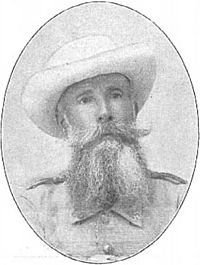Joaquín Vara de Rey y Rubio facts for kids
Quick facts for kids
Joaquín Vara de Rey y Rubio
|
|
|---|---|
 |
|
| Born | 14 August 1841 Ibiza, Spain |
| Died | 1 July 1898 (aged 56) El Caney, Cuba |
| Allegiance | |
| Service/ |
Spanish Army |
| Years of service | 1862–1898 |
| Rank | Brigadier General |
| Battles/wars | |
| Awards | |
Joaquín Vara de Rey y Rubio (born August 14, 1841 – died July 1, 1898) was a brave Spanish military officer. He is famous for his amazing defense of a small village called El Caney during the Spanish–American War. He and his few soldiers faced a much larger American army, showing incredible courage.
Contents
Early Life and Military Start
Joaquín Vara de Rey was born on August 14, 1841, on the island of Ibiza, which is part of the Balearic Islands of Spain. He began his military journey at the Colegio General. He worked hard and became a second lieutenant, then a first lieutenant in 1862.
Fighting in Spain
During the 1870s, Vara de Rey helped fight against different uprisings in Spain. He fought against groups called cantonalists in cities like Cartagena and Valencia. He also fought against the Carlists in a conflict known as the Third Carlist War. These were important moments in Spanish history.
Serving in the Philippines
In 1884, Vara de Rey asked to be transferred to the Philippines. He stayed there for six years, until 1890. During this time, he served as a military and political governor. He was in charge of the Mariana Islands and also the city of Zamboanga. In 1891, he was promoted to colonel and returned to Spain. There, he was given command of the soldiers stationed in Ávila.
Service in Cuba and the Spanish-American War
In 1895, Joaquín Vara de Rey volunteered to serve in Cuba. This was a time when Cuba was fighting for its independence from Spain.
Victory at Loma del Gato
Vara de Rey commanded Spanish forces in the area of Bayamo. He led his regiment to an important victory at the Battle of Loma del Gato. In this battle, the Spanish soldiers defeated a group of Cuban revolutionaries called Mambises. They even managed to defeat the revolutionary general José Maceo Grajales, who was the brother of another famous Cuban general, Antonio Maceo Grajales.
The Heroic Defense of El Caney
On July 1, 1898, during the Spanish–American War, Vara de Rey was a brigadier general. He was in charge of defending the village of El Caney. He had only about 550 men and two small mountain guns. They faced a huge American army of almost seven thousand soldiers, led by General Henry Ware Lawton.
Vara de Rey was a brilliant leader. He set up his defenses very carefully. He used small, strong buildings called blockhouses. These were placed so that if the American army attacked one blockhouse, soldiers from other blockhouses could fire to help.
The battle lasted for ten hours. It was a very fierce fight. Vara de Rey lost both his brother and a nephew in the battle. He was also badly wounded during the fighting and later died. Only 84 Spanish soldiers survived and managed to retreat to Santiago de Cuba.
A Respected Leader
The American troops were very impressed by Vara de Rey's leadership and bravery. They buried him with full military honors. American accounts of the battle praised the "magnificent courage" of his soldiers. They described Vara de Rey as "an incomparable leader; a heroic soul."
In November 1898, Vara de Rey's remains were sent back to Spain with help from the Americans. After his death, he was given the Laureate Cross of Saint Ferdinand. This is Spain's highest award for military bravery.
Images for kids
-
The Joaquín Vara de Rey Memorial in Ibiza, created by sculptor Eduard Alentorn.
See also
 In Spanish: Joaquín Vara de Rey para niños
In Spanish: Joaquín Vara de Rey para niños


